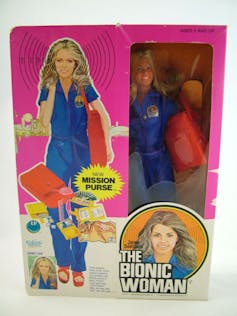
In 1973, the American Broadcasting Company (ABC) first aired The Six Million Dollar Man, a made-for-television movie in which Steve Austin, an astronaut test-piloting a prototype aeroplane, experienced a seemingly unsurvivable crash.
As Austin was removed from the wreckage, “barely alive”, the narrator explained, “Gentlemen, we can rebuild him. We have the technology.
"We have the capability to build the world’s first bionic man. Steve Austin will be that man. Better than he was before. Better, stronger, faster.”
What followed was nothing short of a global phenomenon. As a young boy attending school in California at the time, I vividly recall the day after this film aired. The narrator’s words were on everyone’s lips: “better, stronger, faster”.
We could now run faster with our imaginary bionic legs, lift incredible weight with our imaginary bionic arm, and read the date on a coin from kilometres away with our imaginary bionic eye.
The series that was inspired by the movie, and its spin-off program “The Bionic Woman” (Jamie Sommers had similar injuries to Steve from a skydiving accident, but instead of losing an eye she lost an ear), went on for five seasons, complete with accompanying toy action figures, comic books, wall posters, Halloween costumes and the like (some of which are still available on eBay!). It was huge.
Time has not treated these series well. Nearly 40 years later on late-night reruns, the special effects look cheesy and awkward, the storylines contrived and the sound effects – well, we all loved those sound effects so I won’t go there …
One wonders what $6 million could buy today. Surely what was fantasy in 1973 is reality now, right? Do we “have the technology”?
Where we stand
Sensory auditory neuroprostheses – bionic ears, if you will – have come the closest to meeting the expectations set out for us by Jamie Sommers’ pioneering bionic hearing which, week after week, saved the day by allowing her to hear the sinister plans of villians.
Today, more than 100,000 people around the world can hear again as a result of bionic ears – at least 70% of them using technology designed and built in Australia by Cochlear Limited. The results are nothing short of incredible.
I had the honour of working for Cochlear during the 1990s when the technology was first gaining acceptance as a genuine treatment for deafness.
As I commuted home on the train one day after work, I sat next to a woman who was wearing a small, round object behind her ear that looked a bit like the Mercedes Benz emblem.
I recognised it as being one of our implants – one of the implants I had helped to make safe and effective (I was so proud – even though I was just one of about 25 engineers working at the company at the time).
I pulled a business card from my wallet and showed it to the lady. She described how, when the device was first switched on, it sounded like “Donald Duck” and how, after a while, the people she knew from before she went deaf began to sound exactly the same as she remembered.
For me (who spent most days in a laboratory testing silicone polymers, ceramic encapsulations, radio telemetry and the fatigue resistance of platinum electrodes) this chance meeting made my day.
Better, stronger, faster
The promise of bionic limbs that can allow one to run 100 kilometres an hour and lift cars over their head has not quite lived up to expectations.
Certainly the robotics available today have these capabilities, but controlling these replacements to amputated legs and arms so that they can be used beneficially has proven far less successful than we, on the school yard in 1973, might have imagined.
An issue of coordination
As we walk, signals from our brain precisely control numerous muscles simultaneously. A robot can control numerous actuators simultaneously but only through the use of electronic signals that dictate when and where the movement is to occur.
When a bionic limb is used to replace a lost limb, the signals that once controlled the fingers, toes, and other muscles in the original sit dormant inside the remaining part of the limb.
The signals are still there, but accessing and deciphering them is a monumental task.
Signals are carried within the body by nerves. Nerve cells often contain axons (nerve fibers) that can extend long distances from the nerve cell’s body in order to transmit signals called “action potentials”.
When an action potential arrives at its destination, the result can be the contraction of a muscle, the hearing of a noise, the feeling of pain, or the experience of a memory.
Detecting these action potentials can, and in many cases do, tell us what has happened or what should happen next.
The problem is that there are billions of nerve cells, and they like to travel in groups – often enormous groups of thousands or millions of axons.
Knowing which one to listen to, and indeed how to listen to it, is what we haven’t been able to do particularly well. Yet.
We can do a few, basic commands (move arm, close fingers, open fingers, etc.) but so far coordinated movement has eluded us.
We like it difficult
Steve Austin’s bionic eye was not only the most far-fetched component of his $6 million bionic ensemble; it has also been the most sought-after goal in the field of implantable bionics in recent decades.
Today there are actually people walking around the streets of Germany, Britain, the United States and a growing number of other places with prototype bionic eyes.
The Australian Government has recently committed an incredible $50 million in research funding for us to achieve what was once believed to be impossible – to make the blind see again.
I say “us” because I am one of the lead researchers on one of two teams funded by the Australian Research Council to achieve this objective by 2014.
One year into the four year project, all signs are indicating that we’re going to do it, and soon people will be walking around the streets of Australia with a bionic eye.
The six million dollar question
Did Steve Austin and Jamie Sommers foretell the future, or did they simply set expectations too high for humans to ever develop technologies that would satisfactorily assist in overcoming extensive injuries from crashing planes or skydiving accidents?
As a kid on a playground in 1973, it certainly looked achievable.
Four decades later, as the coordinator of a course called “Implantable Bionics” at the University of New South Wales, I’m still a believer.

